ECU SKODA FABIA 2014 3.G / NJ Operating Instruction Manual
[x] Cancel search | Manufacturer: SKODA, Model Year: 2014, Model line: FABIA, Model: SKODA FABIA 2014 3.G / NJPages: 216, PDF Size: 30.9 MB
Page 11 of 216
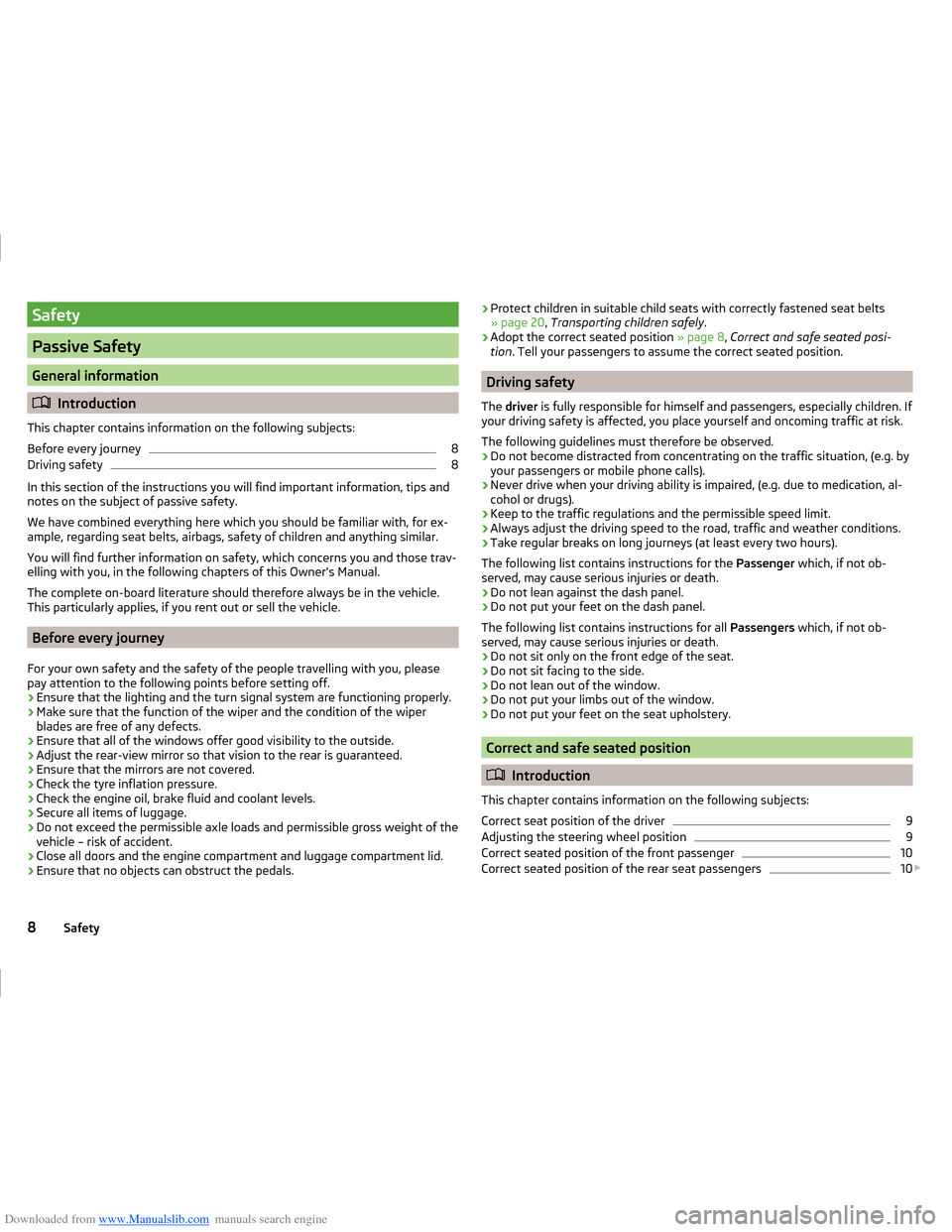
Downloaded from www.Manualslib.com manuals search engine Safety
Passive Safety
General information
Introduction
This chapter contains information on the following subjects:
Before every journey
8
Driving safety
8
In this section of the instructions you will find important information, tips and
notes on the subject of passive safety.
We have combined everything here which you should be familiar with, for ex-
ample, regarding seat belts, airbags, safety of children and anything similar.
You will find further information on safety, which concerns you and those trav-
elling with you, in the following chapters of this Owner's Manual.
The complete on-board literature should therefore always be in the vehicle.
This particularly applies, if you rent out or sell the vehicle.
Before every journey
For your own safety and the safety of the people travelling with you, please
pay attention to the following points before setting off.
› Ensure that the lighting and the turn signal system are functioning properly.
› Make sure that the function of the wiper and the condition of the wiper
blades are free of any defects.
› Ensure that all of the windows offer good visibility to the outside.
› Adjust the rear-view mirror so that vision to the rear is guaranteed.
› Ensure that the mirrors are not covered.
› Check the tyre inflation pressure.
› Check the engine oil, brake fluid and coolant levels.
› Secure all items of luggage.
› Do not exceed the permissible axle loads and permissible gross weight of the
vehicle – risk of accident.
› Close all doors and the engine compartment and luggage compartment lid.
› Ensure that no objects can obstruct the pedals.
›Protect children in suitable child seats with correctly fastened seat belts
» page 20 , Transporting children safely .
› Adopt the correct seated position
» page 8, Correct and safe seated posi-
tion . Tell your passengers to assume the correct seated position.
Driving safety
The driver is fully responsible for himself and passengers, especially children. If
your driving safety is affected, you place yourself and oncoming traffic at risk.
The following guidelines must therefore be observed. › Do not become distracted from concentrating on the traffic situation, (e.g. by
your passengers or mobile phone calls).
› Never drive when your driving ability is impaired, (e.g. due to medication, al-
cohol or drugs).
› Keep to the traffic regulations and the permissible speed limit.
› Always adjust the driving speed to the road, traffic and weather conditions.
› Take regular breaks on long journeys (at least every two hours).
The following list contains instructions for the Passenger which, if not ob-
served, may cause serious injuries or death.
› Do not lean against the dash panel.
› Do not put your feet on the dash panel.
The following list contains instructions for all Passengers which, if not ob-
served, may cause serious injuries or death.
› Do not sit only on the front edge of the seat.
› Do not sit facing to the side.
› Do not lean out of the window.
› Do not put your limbs out of the window.
› Do not put your feet on the seat upholstery.
Correct and safe seated position
Introduction
This chapter contains information on the following subjects:
Correct seat position of the driver
9
Adjusting the steering wheel position
9
Correct seated position of the front passenger
10
Correct seated position of the rear seat passengers
10
8Safety
Page 23 of 216
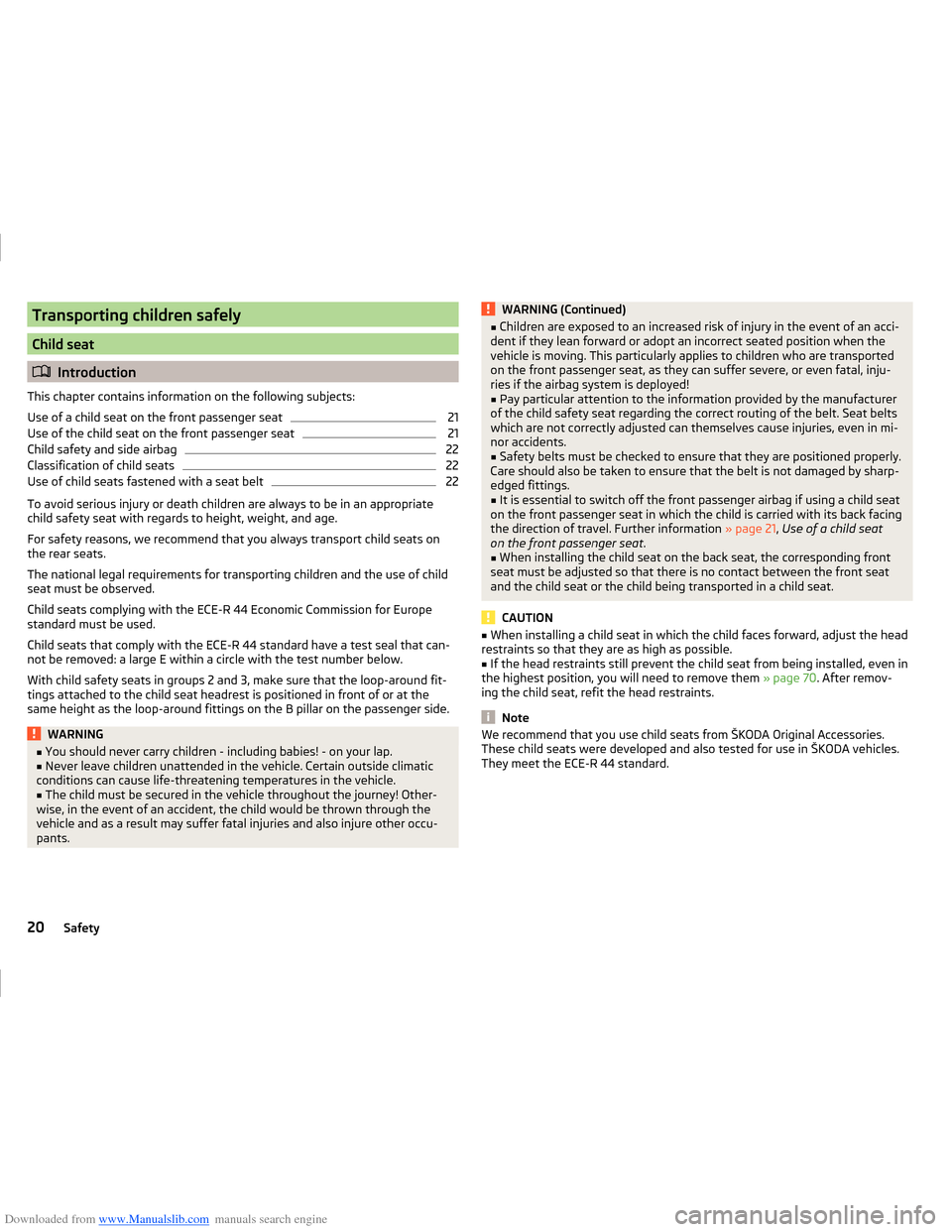
Downloaded from www.Manualslib.com manuals search engine Transporting children safely
Child seat
Introduction
This chapter contains information on the following subjects:
Use of a child seat on the front passenger seat
21
Use of the child seat on the front passenger seat
21
Child safety and side airbag
22
Classification of child seats
22
Use of child seats fastened with a seat belt
22
To avoid serious injury or death children are always to be in an appropriate
child safety seat with regards to height, weight, and age.
For safety reasons, we recommend that you always transport child seats on the rear seats.
The national legal requirements for transporting children and the use of child
seat must be observed.
Child seats complying with the ECE-R 44 Economic Commission for Europe
standard must be used.
Child seats that comply with the ECE-R 44 standard have a test seal that can-
not be removed: a large E within a circle with the test number below.
With child safety seats in groups 2 and 3, make sure that the loop-around fit-
tings attached to the child seat headrest is positioned in front of or at the
same height as the loop-around fittings on the B pillar on the passenger side.
WARNING■ You should never carry children - including babies! - on your lap.■Never leave children unattended in the vehicle. Certain outside climatic
conditions can cause life-threatening temperatures in the vehicle.■
The child must be secured in the vehicle throughout the journey! Other-
wise, in the event of an accident, the child would be thrown through the
vehicle and as a result may suffer fatal injuries and also injure other occu-
pants.
WARNING (Continued)■ Children are exposed to an increased risk of injury in the event of an acci-
dent if they lean forward or adopt an incorrect seated position when the
vehicle is moving. This particularly applies to children who are transported
on the front passenger seat, as they can suffer severe, or even fatal, inju-
ries if the airbag system is deployed!■
Pay particular attention to the information provided by the manufacturer
of the child safety seat regarding the correct routing of the belt. Seat belts
which are not correctly adjusted can themselves cause injuries, even in mi-
nor accidents.
■
Safety belts must be checked to ensure that they are positioned properly.
Care should also be taken to ensure that the belt is not damaged by sharp-
edged fittings.
■
It is essential to switch off the front passenger airbag if using a child seat
on the front passenger seat in which the child is carried with its back facing
the direction of travel. Further information » page 21, Use of a child seat
on the front passenger seat .
■
When installing the child seat on the back seat, the corresponding front
seat must be adjusted so that there is no contact between the front seat
and the child seat or the child being transported in a child seat.
CAUTION
■ When installing a child seat in which the child faces forward, adjust the head
restraints so that they are as high as possible.■
If the head restraints still prevent the child seat from being installed, even in
the highest position, you will need to remove them » page 70. After remov-
ing the child seat, refit the head restraints.
Note
We recommend that you use child seats from ŠKODA Original Accessories.
These child seats were developed and also tested for use in ŠKODA vehicles.
They meet the ECE-R 44 standard.20Safety
Page 25 of 216
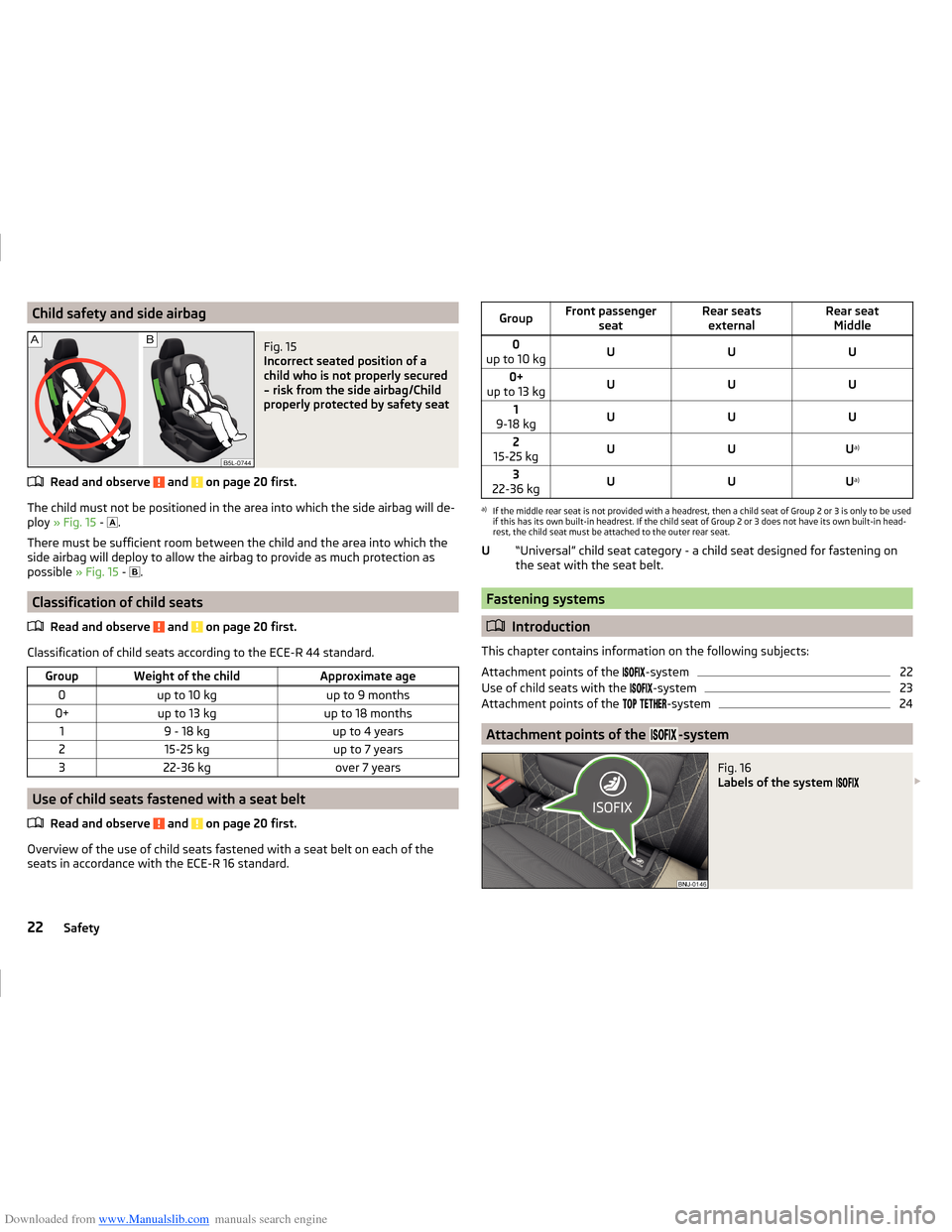
Downloaded from www.Manualslib.com manuals search engine Child safety and side airbagFig. 15
Incorrect seated position of a
child who is not properly secured
– risk from the side airbag/Child
properly protected by safety seat
Read and observe and on page 20 first.
The child must not be positioned in the area into which the side airbag will de- ploy » Fig. 15 -
.
There must be sufficient room between the child and the area into which the
side airbag will deploy to allow the airbag to provide as much protection as
possible » Fig. 15 -
.
Classification of child seats
Read and observe
and on page 20 first.
Classification of child seats according to the ECE-R 44 standard.
GroupWeight of the childApproximate age0up to 10 kgup to 9 months0+up to 13 kgup to 18 months19 - 18 kgup to 4 years215-25 kgup to 7 years322-36 kgover 7 years
Use of child seats fastened with a seat belt Read and observe
and on page 20 first.
Overview of the use of child seats fastened with a seat belt on each of the
seats in accordance with the ECE-R 16 standard.
GroupFront passenger seatRear seatsexternalRear seat Middle0
up to 10 kgUUU0+
up to 13 kgUUU1
9-18 kgUUU2
15-25 kgUUU a)3
22-36 kgUUU a)a)
If the middle rear seat is not provided with a headrest, then a child seat of Group 2 or 3 is only to be used
if this has its own built-in headrest. If the child seat of Group 2 or 3 does not have its own built-in head-
rest, the child seat must be attached to the outer rear seat.
“Universal” child seat category - a child seat designed for fastening on
the seat with the seat belt.
Fastening systems
Introduction
This chapter contains information on the following subjects:
Attachment points of the -system
22
Use of child seats with the
-system
23
Attachment points of the
-system
24
Attachment points of the -system
Fig. 16
Labels of the system
U22Safety
Page 26 of 216
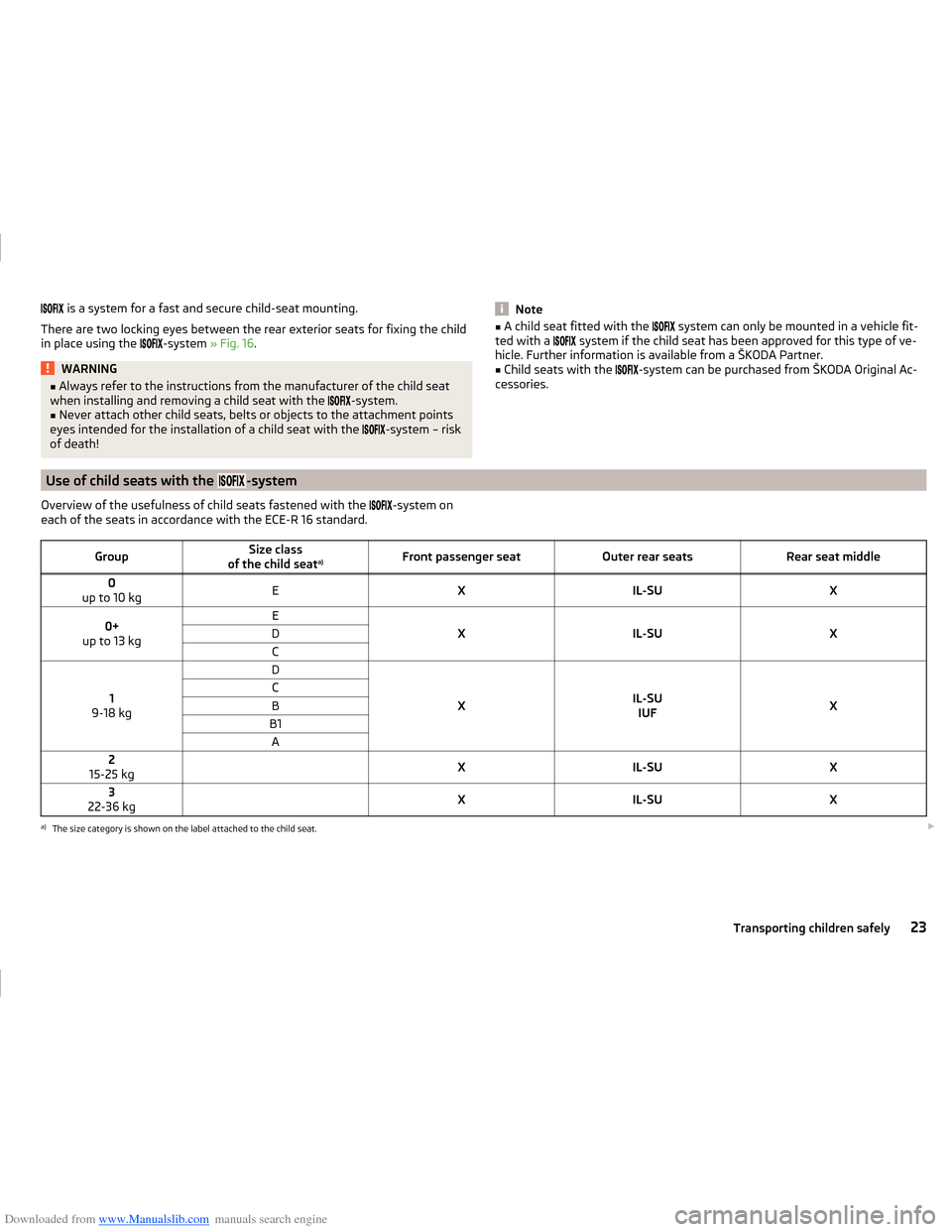
Downloaded from www.Manualslib.com manuals search engine is a system for a fast and secure child-seat mounting.
There are two locking eyes between the rear exterior seats for fixing the child in place using the
-system » Fig. 16.WARNING■
Always refer to the instructions from the manufacturer of the child seat
when installing and removing a child seat with the -system.■
Never attach other child seats, belts or objects to the attachment points
eyes intended for the installation of a child seat with the
-system – risk
of death!
Note■ A child seat fitted with the system can only be mounted in a vehicle fit-
ted with a system if the child seat has been approved for this type of ve-
hicle. Further information is available from a ŠKODA Partner.■
Child seats with the
-system can be purchased from ŠKODA Original Ac-
cessories.
Use of child seats with the -system
Overview of the usefulness of child seats fastened with the -system on
each of the seats in accordance with the ECE-R 16 standard.GroupSize class
of the child seat a)Front passenger seatOuter rear seatsRear seat middle0
up to 10 kgEXIL-SUX0+
up to 13 kgE
XIL-SUX
DC
1
9-18 kg
D
XIL-SU IUFX
CBB1A2
15-25 kg XIL-SUX3
22-36 kg XIL-SUXa)
The size category is shown on the label attached to the child seat.
23Transporting children safely
Page 75 of 216
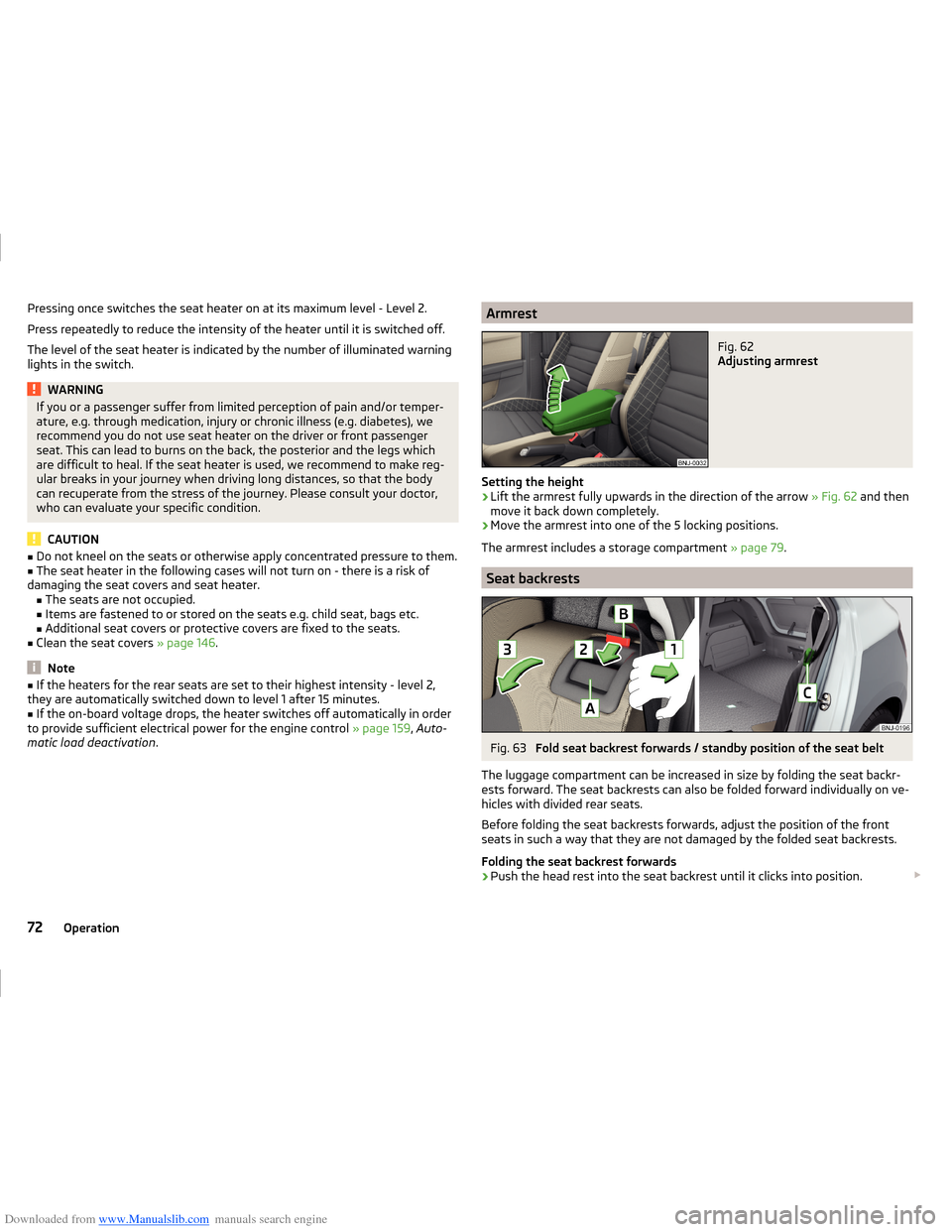
Downloaded from www.Manualslib.com manuals search engine Pressing once switches the seat heater on at its maximum level - Level 2.
Press repeatedly to reduce the intensity of the heater until it is switched off.
The level of the seat heater is indicated by the number of illuminated warning
lights in the switch.WARNINGIf you or a passenger suffer from limited perception of pain and/or temper-
ature, e.g. through medication, injury or chronic illness (e.g. diabetes), we
recommend you do not use seat heater on the driver or front passenger
seat. This can lead to burns on the back, the posterior and the legs which
are difficult to heal. If the seat heater is used, we recommend to make reg-
ular breaks in your journey when driving long distances, so that the body
can recuperate from the stress of the journey. Please consult your doctor,
who can evaluate your specific condition.
CAUTION
■ Do not kneel on the seats or otherwise apply concentrated pressure to them.■The seat heater in the following cases will not turn on - there is a risk of
damaging the seat covers and seat heater. ■The seats are not occupied.
■ Items are fastened to or stored on the seats e.g. child seat, bags etc.
■ Additional seat covers or protective covers are fixed to the seats.■
Clean the seat covers » page 146.
Note
■
If the heaters for the rear seats are set to their highest intensity - level 2,
they are automatically switched down to level 1 after 15 minutes.■
If the on-board voltage drops, the heater switches off automatically in order
to provide sufficient electrical power for the engine control » page 159, Auto-
matic load deactivation .
ArmrestFig. 62
Adjusting armrest
Setting the height
›
Lift the armrest fully upwards in the direction of the arrow » Fig. 62 and then
move it back down completely.
›
Move the armrest into one of the 5 locking positions.
The armrest includes a storage compartment » page 79.
Seat backrests
Fig. 63
Fold seat backrest forwards / standby position of the seat belt
The luggage compartment can be increased in size by folding the seat backr-
ests forward. The seat backrests can also be folded forward individually on ve-
hicles with divided rear seats.
Before folding the seat backrests forwards, adjust the position of the front
seats in such a way that they are not damaged by the folded seat backrests.
Folding the seat backrest forwards
›
Push the head rest into the seat backrest until it clicks into position.
72Operation
Page 76 of 216
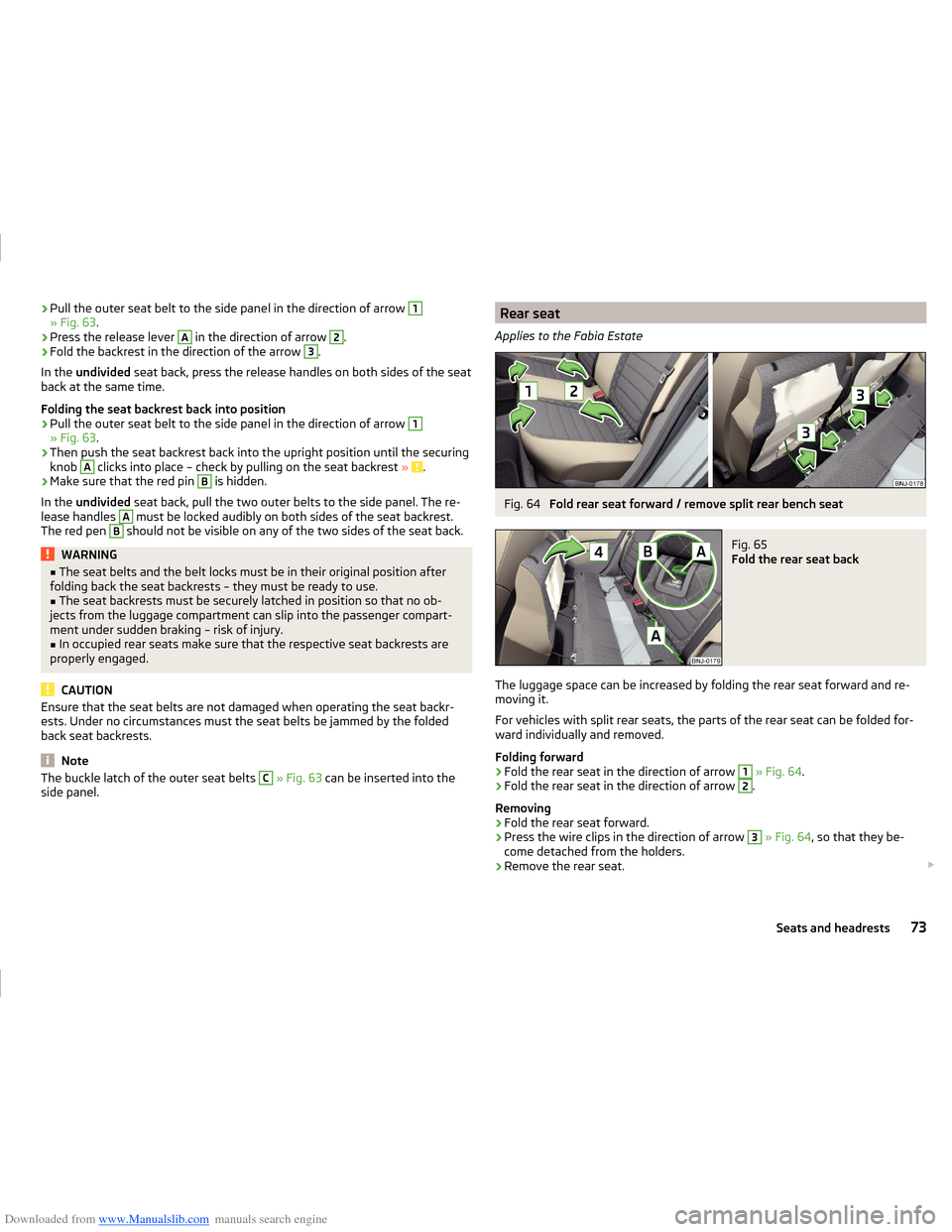
Downloaded from www.Manualslib.com manuals search engine ›Pull the outer seat belt to the side panel in the direction of arrow 1» Fig. 63
.›
Press the release lever
A
in the direction of arrow
2
.
›
Fold the backrest in the direction of the arrow
3
.
In the undivided seat back, press the release handles on both sides of the seat
back at the same time.
Folding the seat backrest back into position
›
Pull the outer seat belt to the side panel in the direction of arrow
1
» Fig. 63 .
›
Then push the seat backrest back into the upright position until the securing
knob
A
clicks into place – check by pulling on the seat backrest » .
›
Make sure that the red pin
B
is hidden.
In the undivided seat back, pull the two outer belts to the side panel. The re-
lease handles
A
must be locked audibly on both sides of the seat backrest.
The red pen
B
should not be visible on any of the two sides of the seat back.
WARNING■ The seat belts and the belt locks must be in their original position after
folding back the seat backrests – they must be ready to use.■
The seat backrests must be securely latched in position so that no ob-
jects from the luggage compartment can slip into the passenger compart-
ment under sudden braking – risk of injury.
■
In occupied rear seats make sure that the respective seat backrests are
properly engaged.
CAUTION
Ensure that the seat belts are not damaged when operating the seat backr-
ests. Under no circumstances must the seat belts be jammed by the folded
back seat backrests.
Note
The buckle latch of the outer seat belts C » Fig. 63 can be inserted into the
side panel.Rear seat
Applies to the Fabia EstateFig. 64
Fold rear seat forward / remove split rear bench seat
Fig. 65
Fold the rear seat back
The luggage space can be increased by folding the rear seat forward and re-
moving it.
For vehicles with split rear seats, the parts of the rear seat can be folded for-
ward individually and removed.
Folding forward
›
Fold the rear seat in the direction of arrow
1
» Fig. 64 .
›
Fold the rear seat in the direction of arrow
2
.
Removing
›
Fold the rear seat forward.
›
Press the wire clips in the direction of arrow
3
» Fig. 64 , so that they be-
come detached from the holders.
›
Remove the rear seat.
73Seats and headrests
Page 77 of 216
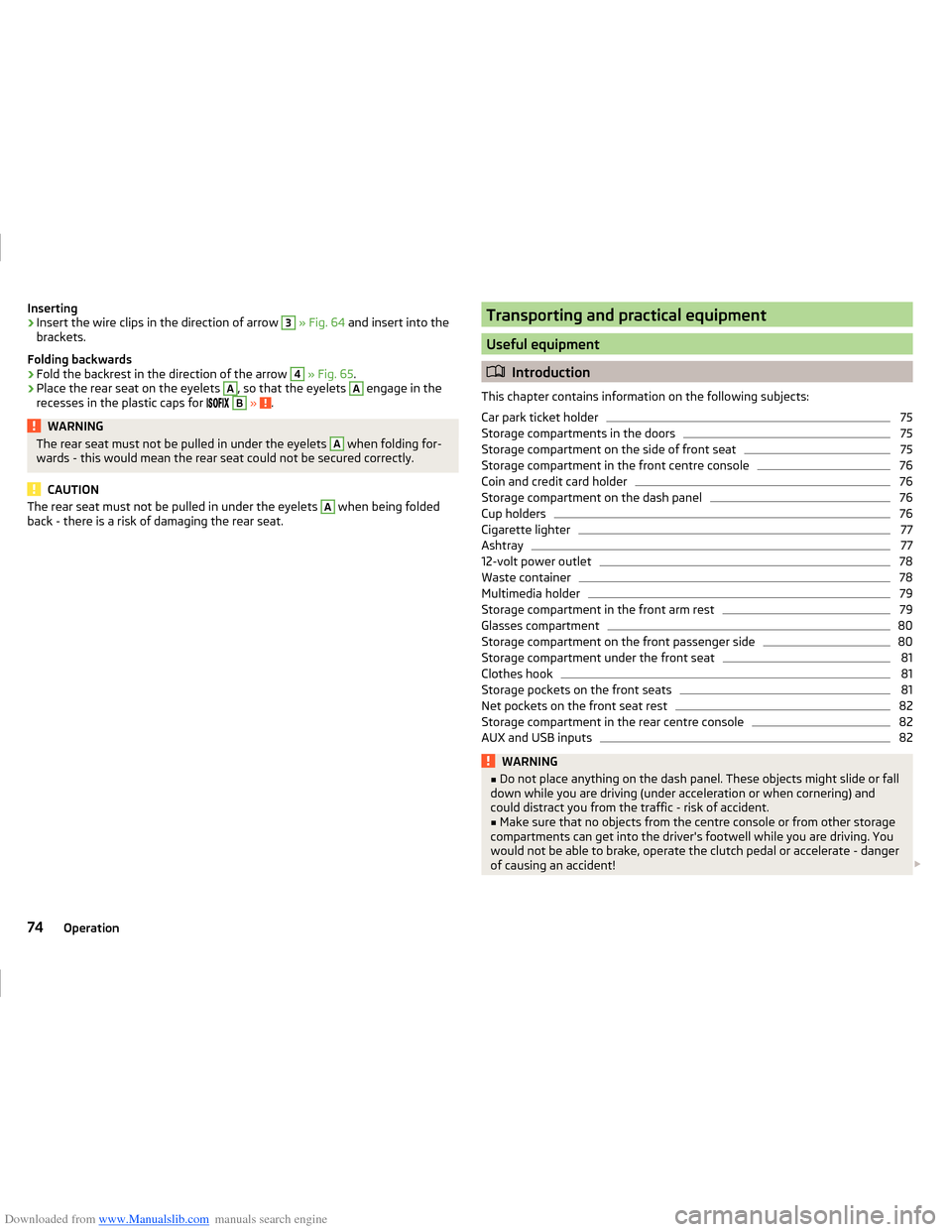
Downloaded from www.Manualslib.com manuals search engine Inserting›Insert the wire clips in the direction of arrow 3 » Fig. 64 and insert into the
brackets.
Folding backwards›
Fold the backrest in the direction of the arrow
4
» Fig. 65 .
›
Place the rear seat on the eyelets
A
, so that the eyelets
A
engage in the
recesses in the plastic caps for
B
» .
WARNINGThe rear seat must not be pulled in under the eyelets A when folding for-
wards - this would mean the rear seat could not be secured correctly.
CAUTION
The rear seat must not be pulled in under the eyelets A when being folded
back - there is a risk of damaging the rear seat.Transporting and practical equipment
Useful equipment
Introduction
This chapter contains information on the following subjects:
Car park ticket holder
75
Storage compartments in the doors
75
Storage compartment on the side of front seat
75
Storage compartment in the front centre console
76
Coin and credit card holder
76
Storage compartment on the dash panel
76
Cup holders
76
Cigarette lighter
77
Ashtray
77
12-volt power outlet
78
Waste container
78
Multimedia holder
79
Storage compartment in the front arm rest
79
Glasses compartment
80
Storage compartment on the front passenger side
80
Storage compartment under the front seat
81
Clothes hook
81
Storage pockets on the front seats
81
Net pockets on the front seat rest
82
Storage compartment in the rear centre console
82
AUX and USB inputs
82WARNING■ Do not place anything on the dash panel. These objects might slide or fall
down while you are driving (under acceleration or when cornering) and
could distract you from the traffic - risk of accident.■
Make sure that no objects from the centre console or from other storage
compartments can get into the driver's footwell while you are driving. You
would not be able to brake, operate the clutch pedal or accelerate - danger
of causing an accident!
74Operation
Page 85 of 216
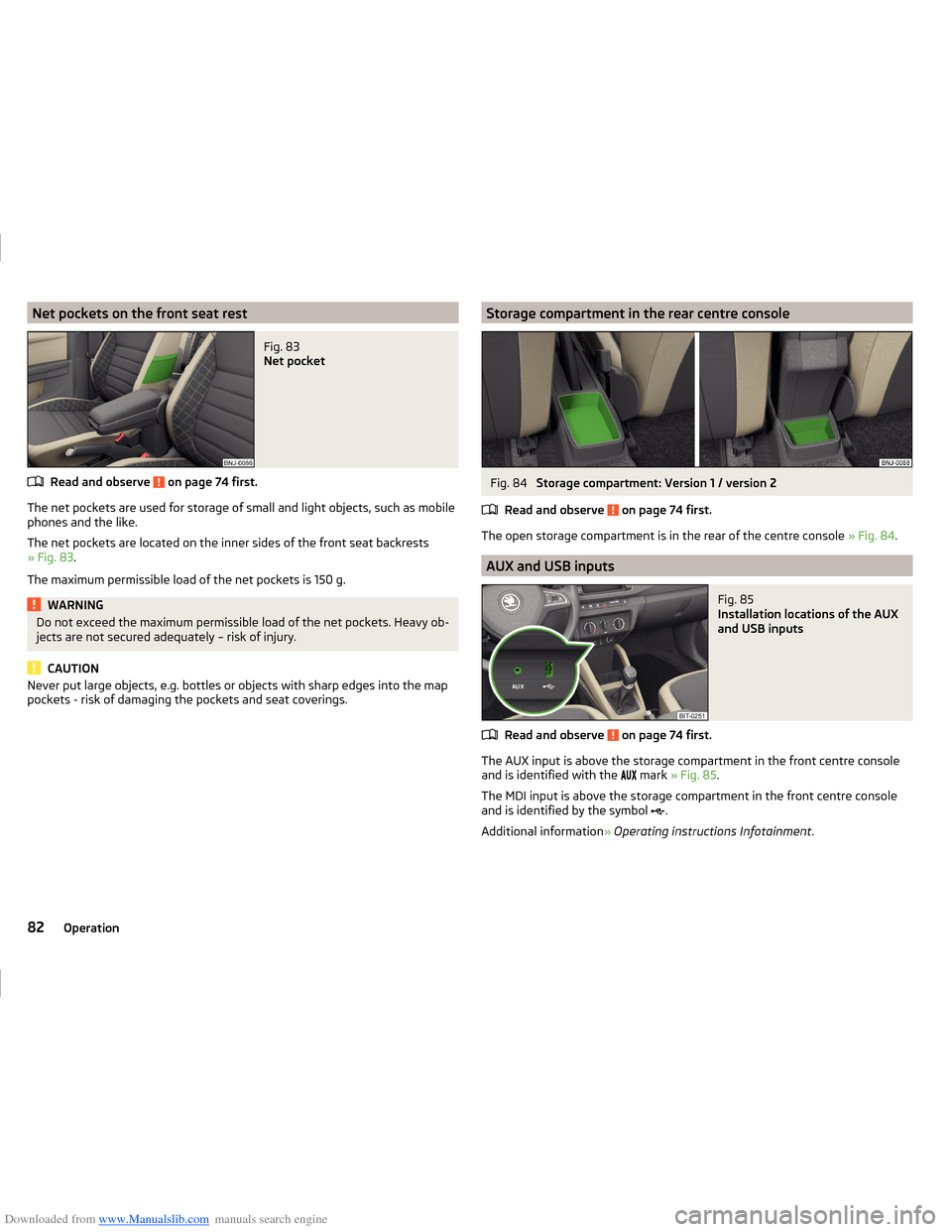
Downloaded from www.Manualslib.com manuals search engine Net pockets on the front seat restFig. 83
Net pocket
Read and observe on page 74 first.
The net pockets are used for storage of small and light objects, such as mobile
phones and the like.
The net pockets are located on the inner sides of the front seat backrests
» Fig. 83 .
The maximum permissible load of the net pockets is 150 g.
WARNINGDo not exceed the maximum permissible load of the net pockets. Heavy ob-
jects are not secured adequately – risk of injury.
CAUTION
Never put large objects, e.g. bottles or objects with sharp edges into the map
pockets - risk of damaging the pockets and seat coverings.Storage compartment in the rear centre consoleFig. 84
Storage compartment: Version 1 / version 2
Read and observe
on page 74 first.
The open storage compartment is in the rear of the centre console » Fig. 84.
AUX and USB inputs
Fig. 85
Installation locations of the AUX
and USB inputs
Read and observe on page 74 first.
The AUX input is above the storage compartment in the front centre console
and is identified with the mark
» Fig. 85 .
The MDI input is above the storage compartment in the front centre console
and is identified by the symbol .
Additional information » Operating instructions Infotainment .
82Operation
Page 87 of 216

Downloaded from www.Manualslib.com manuals search engine Fastening elementsFig. 86
Fasteners
Read and observe and on page 83 first.
Overview of the fasteners » Fig. 86
Lashing eyes for fastening items of luggage and fixing nets
Fastening element only for fastening fixing nets
Lashing eyes only for fastening fixing nets
The upper front lashing eye
C
is located behind the folding rear seat backrest.
The maximum permissible static load of the individual lashing eyes
A
is 3.5 kN
(350 kg).
CAUTION
The lashing eyelets A cannot be used for attaching bags and nets when the
variable loading floor is in the upper position » page 891)
.ABCFixing netsFig. 87
Fastening examples for nets
Fig. 88
Fastening vertical pocket
Read and observe and on page 83 first.
Securing of the nets » Fig. 87 and » Fig. 88
Horizontal pocket
Floor net
Vertical pocket (only applies to some vehicles)
The maximum permissible load of the fixing nets is 1.5 kg.
WARNINGDo not exceed the maximum permissible load of the fixing nets. Heavy ob-
jects are not secured adequately – risk of injury. ABC1)
Applies to vehicles with a variable loading floor.
84Operation
Page 90 of 216

Downloaded from www.Manualslib.com manuals search engine In the front area, slots B » Fig. 91 on page 86 on the cover must be fully en-
gaged with the bolts on the side trim. In the back, the cover must be secured
at both ends under the latching.
In the lower position, the cover is designed for storing small objects up to a
weight of 2.5 kg in total.
Roll-up cover
Fig. 93
Roll-up cover: Pull-out / roll-up / remove
Read and observe
and on page 83 first.
Pulling out
›
Grasp the cover on handle
A
and pull it out in the direction of the arrow
1
until it clicks audibly into the secured position » Fig. 93.
Rolling up
›
Push the cover in the area of handle
A
in the direction of the arrow
2
» Fig. 93 .
The cover rolls up automatically.
Removing
›
The cover can be rolled up before removing.
›
Press on the side of the cross bar in the direction of arrow
3
and remove
the cover in the arrow direction
4
» Fig. 93 .
Inserting
›
First insert the cover on the left side.
›
Press on the side of the cross bar in the direction of arrow
3
and insert the
cover against arrow direction
4
» Fig. 93 .
WARNINGNo objects should be placed on the foldable boot cover. There is the danger
of injuries during sudden braking or vehicle impact.
Storage compartments under the floor
Fig. 94
Fold the floor back / storage compartment under the floor
Read and observe
and on page 83 first.
The storage compartment is located under the luggage compartment floor
» Fig. 94 -
.
›
Lift the rear portion of the floor and fold forward in the direction of arrow
» Fig. 94 -
.
The storage compartment is designed for storing small objects of up to 15 kg. in weight in total.
CAUTION
■ The following instructions must be observed to avoid damage to the storage
compartment. ■ Do not store any sharp objects in the storage compartment.
■ Place the items carefully into the storage compartment.
■ Do not place pressure on any points in the storage compartment.87Transporting and practical equipment